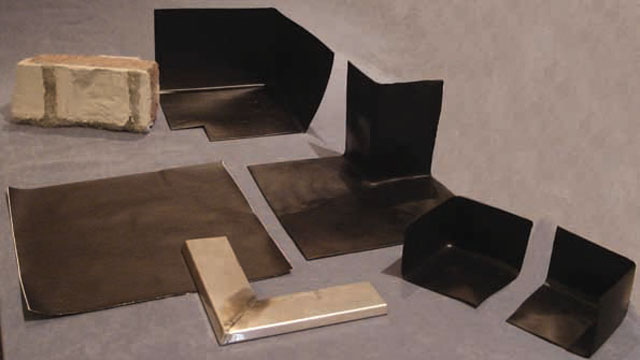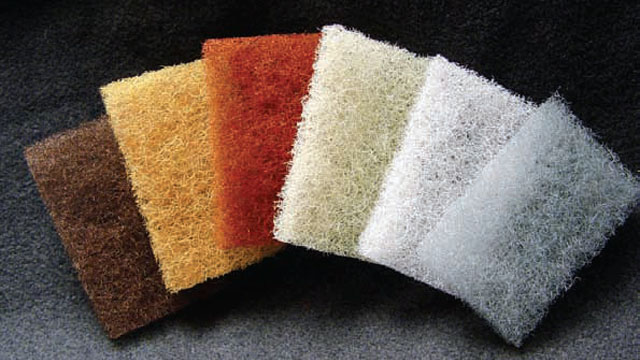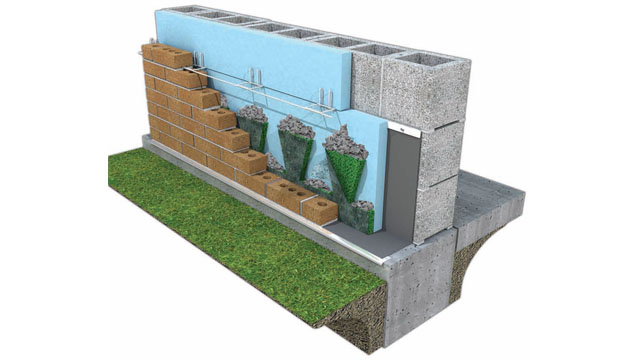July 5, 2011 7:00 AM CDT
As this article is written, snow covers the landscape, as well as concrete block cubes, brick hacks and other pallets of materials on many jobsites. Yes, many of us cover and protect our materials; however, materials saturated from the elements are still installed in our projects, introducing the first moisture to our cavities. As construction often does in the months that get more precipitation, it can start and stop unexpectedly due to the weather. This creates opportunity for wall protection to blow off of the walls and allow in-place work to become saturated. Though both conditions are seasonal, they occur typically at the beginning and end of our busiest season, when our workforce is its strongest. With this in mind, both issues are simply a site management issue, which is one of the easiest problems for us to solve.
When choosing materials available for jobs today, it is important to do your homework and select products that function as advertised with a proven performance record.
Mortar can be mixed with the same basic admixture that concrete block can be manufactured with, which almost completely repels water and virtually will not allow moisture absorption or infiltration through the body of the product. Products of this nature are inherent and remain as a functioning component of the wall through the lifetime of the building. Moisture prevention is moisture management.
Mortar collection devices are another important feature within a cavity wall that contributes to effective moisture removal from the cavity. The mortar collection device is important, because it creates a separation or break in the mortar droppings that fall into the cavity during construction. The break in the mortar allows the moisture in the cavity to flow past the droppings and out through the weeps in the face of the wall.
Several products and methods that are available represent the various schools of thoughts on the mortar collection system that you choose. Pea gravel, a common collection device, is less efficient in comparison to available products in today’s market, because it does not break up the mortar. As the mortar droppings fall into the cavity they create a straight strip of mortar, which continually bridges the cavity, allowing moisture that forms in the cavity to saturate the droppings and allow the possibility of mold and rot in the cavity. Mortar that bridges across the cavity, either at the base of the wall or over a window head, potentially creates the opportunity for splotchy efflorescence bloom. This will remain active as long as moisture fills the cavity.

Flashings are the most important component of the cavity wall system with the exception of the exterior veneer. Many products exist and many products claim to be the best, however every product has initial cost as well as hidden costs that often are not estimated or tracked within a project. Site fabrication, picking up materials at the supplier, and installing components of varied lengths can become cumbersome as well as produce waste greater than estimated.
When designing flashing systems it is important that the membrane extend to the front face of the wall (with the exception of an asphalt-based membrane). If this condition is not met, then the flashing can allow the moisture that is draining to the exterior of the building to fall short and enter the cores or cells of the veneer. Water that enters the interior of the veneer is slow to evaporate, especially during the cooler months of the year.
Drip edges manufactured with plastic, stainless steel, copper or a Kynar finish are essential to the overall performance of the flashing system and membrane, because it allows the cavity moisture an avenue to escape beyond the face of the veneer. Use of the exposed drip edge is recommended for overall flashing performance as well as a tool showing owners and architects visual proof that the system is designed as intended.
End dams and corner boots can be purchased as injection molded boots. The benefit of the injected boots and end dams is that they do not leak and they are ready to install. Flashings that the contractor needs to fold and cut require additional trained labor to create a sealed secure corner or end dam. This process can be further complicated by the addition and application of a primer on the adhesive side off the substrate.

Weep tubes, cotton rope wicks and open head joints are not preferred as they have been proven to create issues for the building occupants. The three systems have been installed successfully in thousands of buildings. However, the systems noted have a greater ability for insects to enter the cavity. Clogging of the tubes is common, and weep blockage due to disintegration of the cotton rope wicks is often observed.
In cast and cut stone applications, where split tab anchors are utilized, a common trend to use colored polypropylene mesh weeps laid in the bed joint with stone shims on both sides for additional support allows for a discrete method to aid in cavity drainage.
Air barriers, damproofing and building wraps allow for the systems approach in creating an energy-efficient living space for the residence of the building. More designers and contractors agree that the system chosen is based on overall system performance. The importance of proving that the ASTM standards are currently met, manufacturer installation instructions are followed and mil thicknesses are achieved will pay dividends in energy efficiency and customer satisfaction.
Cavity walls will see a lot of moisture – more than one might think – that would pass through a masonry wall. As a contractor or designer, it becomes our job to construct cavities that function as intended. The products we use and the methods we follow during construction will reflect the performance of the building and, potentially, our reputation within the building community.
Bring on the Rain
Moisture management

Moisture management within the cavity can prevent problems, if addressed at the beginning of construction.
Cavity walls are among the most common walls constructed in today’s market. Moisture management within the cavity can prevent problems, if addressed at the beginning of construction.As this article is written, snow covers the landscape, as well as concrete block cubes, brick hacks and other pallets of materials on many jobsites. Yes, many of us cover and protect our materials; however, materials saturated from the elements are still installed in our projects, introducing the first moisture to our cavities. As construction often does in the months that get more precipitation, it can start and stop unexpectedly due to the weather. This creates opportunity for wall protection to blow off of the walls and allow in-place work to become saturated. Though both conditions are seasonal, they occur typically at the beginning and end of our busiest season, when our workforce is its strongest. With this in mind, both issues are simply a site management issue, which is one of the easiest problems for us to solve.
When choosing materials available for jobs today, it is important to do your homework and select products that function as advertised with a proven performance record.
Mortar can be mixed with the same basic admixture that concrete block can be manufactured with, which almost completely repels water and virtually will not allow moisture absorption or infiltration through the body of the product. Products of this nature are inherent and remain as a functioning component of the wall through the lifetime of the building. Moisture prevention is moisture management.
Mortar collection devices are another important feature within a cavity wall that contributes to effective moisture removal from the cavity. The mortar collection device is important, because it creates a separation or break in the mortar droppings that fall into the cavity during construction. The break in the mortar allows the moisture in the cavity to flow past the droppings and out through the weeps in the face of the wall.
Several products and methods that are available represent the various schools of thoughts on the mortar collection system that you choose. Pea gravel, a common collection device, is less efficient in comparison to available products in today’s market, because it does not break up the mortar. As the mortar droppings fall into the cavity they create a straight strip of mortar, which continually bridges the cavity, allowing moisture that forms in the cavity to saturate the droppings and allow the possibility of mold and rot in the cavity. Mortar that bridges across the cavity, either at the base of the wall or over a window head, potentially creates the opportunity for splotchy efflorescence bloom. This will remain active as long as moisture fills the cavity.

Shown are corner boots and end dams.
Mortar collection devices must fill the cavity completely from the inside face of the veneer to outside face of the interior wall. A two-inch cavity will not function properly with a one-inch or slightly greater dimensioned material installed at an angle in the two-inch cavity, unless the weep tabs are continuous and connected to your mortar collection device, providing a continuous path for moisture to exit the cavity. Because the droppings can fall beside the collection device of improper dimension, the mortar tends to create blockage that extends up from the flashing to the top surface of the collection device, reducing the ability of moisture to exit through the weeps as well as block the weeps from allowing air movement within the cavity. One manufacturer adds an extra benefit to its product with an insect barrier thermally attached to its mortar collection device. In many of our areas, insects are a nuisance that must be controlled by chemicals. With this insect barrier attached to a commonly used product, it can become a convenience as well as a money saver for the occupant of the building. The addition of the insect barrier has been a positive effort in the rebirth of an industry standard.Flashings are the most important component of the cavity wall system with the exception of the exterior veneer. Many products exist and many products claim to be the best, however every product has initial cost as well as hidden costs that often are not estimated or tracked within a project. Site fabrication, picking up materials at the supplier, and installing components of varied lengths can become cumbersome as well as produce waste greater than estimated.
When designing flashing systems it is important that the membrane extend to the front face of the wall (with the exception of an asphalt-based membrane). If this condition is not met, then the flashing can allow the moisture that is draining to the exterior of the building to fall short and enter the cores or cells of the veneer. Water that enters the interior of the veneer is slow to evaporate, especially during the cooler months of the year.
Drip edges manufactured with plastic, stainless steel, copper or a Kynar finish are essential to the overall performance of the flashing system and membrane, because it allows the cavity moisture an avenue to escape beyond the face of the veneer. Use of the exposed drip edge is recommended for overall flashing performance as well as a tool showing owners and architects visual proof that the system is designed as intended.
End dams and corner boots can be purchased as injection molded boots. The benefit of the injected boots and end dams is that they do not leak and they are ready to install. Flashings that the contractor needs to fold and cut require additional trained labor to create a sealed secure corner or end dam. This process can be further complicated by the addition and application of a primer on the adhesive side off the substrate.

Shown are weep vents.
A contractor has many weep options from which to choose as the options range from open head joints, weep tubes, honeycomb inserts, polypropylene colored mesh, metal louvered inserts or cotton rope wicks. Weeps commonly are used in the first course of brick directly above the flashing membrane. However, the placement of a secondary weep system at the top of the cavity allows for air movement. The additional air movement allows faster evaporation of moisture during most months of the year. Weeps are placed at varied distances along the flashing, typically 24 inches on center. One firm manufactures an all-in-one unitized flashing system, where all of the necessary components of an engineered flashing system are pre-assembled in the factory and weeps in the bed joint every six inches.Weep tubes, cotton rope wicks and open head joints are not preferred as they have been proven to create issues for the building occupants. The three systems have been installed successfully in thousands of buildings. However, the systems noted have a greater ability for insects to enter the cavity. Clogging of the tubes is common, and weep blockage due to disintegration of the cotton rope wicks is often observed.
In cast and cut stone applications, where split tab anchors are utilized, a common trend to use colored polypropylene mesh weeps laid in the bed joint with stone shims on both sides for additional support allows for a discrete method to aid in cavity drainage.
Air barriers, damproofing and building wraps allow for the systems approach in creating an energy-efficient living space for the residence of the building. More designers and contractors agree that the system chosen is based on overall system performance. The importance of proving that the ASTM standards are currently met, manufacturer installation instructions are followed and mil thicknesses are achieved will pay dividends in energy efficiency and customer satisfaction.
Cavity walls will see a lot of moisture – more than one might think – that would pass through a masonry wall. As a contractor or designer, it becomes our job to construct cavities that function as intended. The products we use and the methods we follow during construction will reflect the performance of the building and, potentially, our reputation within the building community.
Originally published in Masonry magazine.
About the Author
Steven Fechino is engineering and construction manager with Mortar Net Solutions, makers of TotalFlash and BlockFlash. For more information, call 800-664-6638, or visit www.mortarnet.com.


















